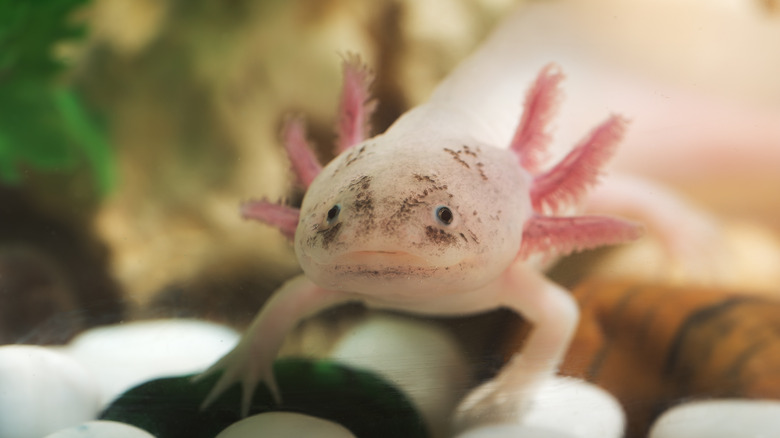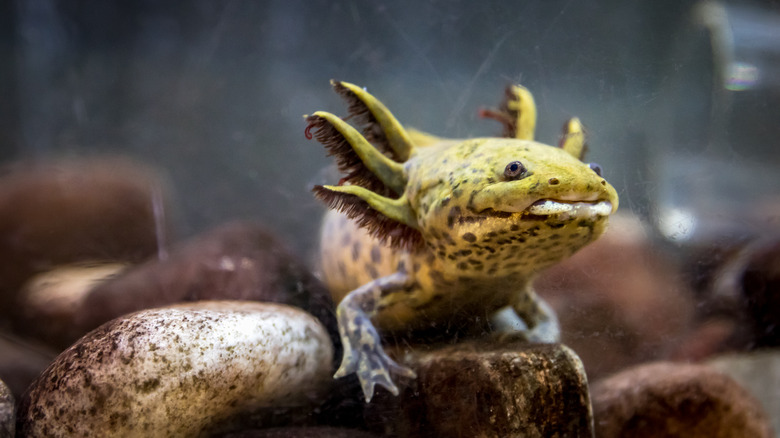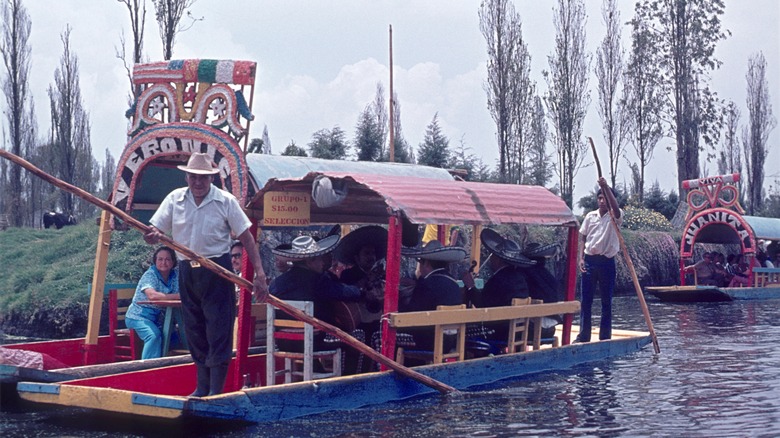The Sad Reason Wild Axolotls Are Critically Endangered
You've probably seen the Mexican walking fish, or axolotl, before. In recent years the amphibian has become an internet sensation, the subject of memes in light-hearted corners of the internet such as Reddit and TikTok. Famous for their cute, apparently smiling faces, axolotls, which are a species of salamander, are frequently compared to cute animated characters, such as Pokemon. Their online celebrity has made the axolotl particularly desirable in the domestic pet market, especially the leucitic white and pink varieties which appear especially cartoonish.
Axolotls are also of great interest to scientists, due to the species' profound and surprising regenerative abilities: like other salamanders, they are able to shed and regrow their limbs. They have also been found to be resistant to cancer cells, raising the possibility that they might be instrumental in developing a cure for cancer among humans.
But while this means that about 1 million axolotls exist in fish tanks worldwide, their habitats in their native Mexico have largely disappeared, while the species has been pushed to the brink of extinction. According to The IUCN Red List of Endangered Species, axolotls are critically endangered, with between 50 and 1000 specimens believed to exist in the wild. One study claims that the population shrank by around 90% between 2005 and 2009 alone, according to the Smithsonian Magazine.
The native axolotl's last remaining habitat
The axolotl's name derives from Xolotl, a fire god worshipped in the Aztec Empire that existed in what is now Mexico in the 15th and 16th centuries, who is said to have transformed himself into a salamander, according to the World Wildlife Fund. The name indicates the amphibian's long cultural importance in the region historically, while today it is still considered a symbol of Mexico as a nation.
However, Mexico itself is proving to be an inhospitable environment for the critically endangered axolotl. The IUCN Red List of Endangered Species claims that the animal is now found living wild in three deep-water locations in the Mexican Central Valley. As the Smithsonian Magazine makes clear, the most important of these to the species' survival is Lake Xochimilco, a body of water southeast of Mexico City which is reportedly the last remaining habitat where native axolotls are found.
In recent decades, the lake has come under pressure from urbanization and pollution to such a degree that it has decimated axolotl numbers. Where previously the axolotl was at the top of the food chain in Lake Xochimilco, the introduction of predatory fish to the water — such as tilapia, which were first released into the area to supply the local fishing industry — have meant that axolotls now have to compete for food sources, while juvenile axolotls have become prey themselves.
Can wild axolotls survive?
The gulf in numbers between the estimated 1 million axolotls in captivity around the world and the few scores still left in their natural habitat is grimly ironic for many naturalists — while humans have proven to be especially fond of the cute and biologically extraordinary animal, little has been collectively achieved to secure their survival in the wild for future generations. And frustratingly, the inbred nature of most of those specimens that exist in captivity means there is little chance of their being reintroduced to the wild for breeding purposes.
Nevertheless, in recent years there have been concerted efforts between scientists and local people in the Mexican Central Valley to improve conditions for wild axolotls. Now, conservation efforts exist through the tourism industry, with local boatmen trained to give tours of the lake and explain the axolotl's role in the area's ecosystem. The fishing industry is also changing, and being encouraged to revert to older methods that ensure the axolotl population has adequate breeding grounds. Pollution and the effects of agricultural runoff also need to be addressed.
Meanwhile, redevelopment of the area as a satellite for commuters working in Mexico City means protectors of the beloved axolotl are fighting on yet another front. Again, it will take the cooperation of experts and locals to give these critically endangered amphibians a fighting chance of staging a miraculous bounceback.


